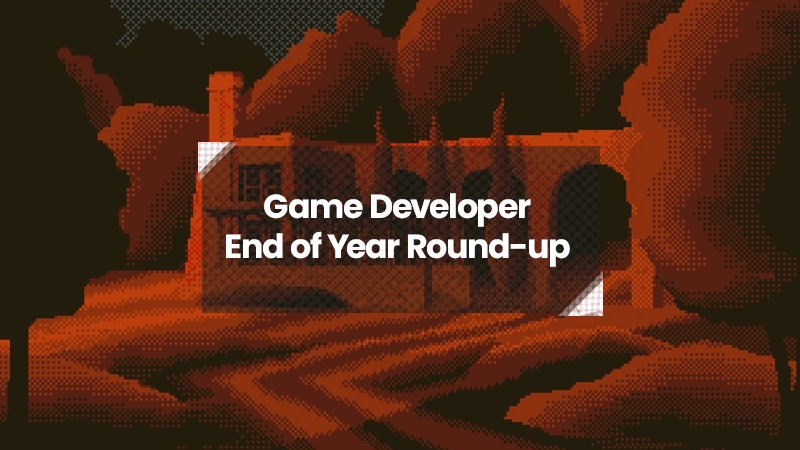Game Developer's 2023 Wrap-Up: 10 Must-Read Deep Dives
This year, our deep dives and postmortems reflected not only the modern games that affect our current lives but also delved into game history and beyond.

Developer Insights is one of the coolest places on Game Developer. And I am not just saying that as the section editor. I’m also saying that as someone who gets to passively benefit from absorbing all this amazing design information every day. I’m getting the education of a lifetime.
This year, our deep dives and postmortems reflected not only the modern games that affect our current lives but also delved into game history: just check out our article with Ken Williams discussing the revival of a nearly 50-year-old game, Colossal Cave, or Jordan Mechner’s history on the cover art for Prince of Persia. We also got a rare look into some unique games with strange origins, including one that was drawn on thousands of Post-It notes, and a horror title made entirely in PowerPoint.
As special as these are, it was almost impossible to cut this list down; the treasure trove of articles we released in 2023 was just too great. Be sure to browse the entire section and, if you’re a developer or publisher, reach out about your own submission. Documenting these games and illuminating the techniques that make them great is our passion and joy and we want to share yours with the world.
Here are ten deep dives you absolutely must read if you missed them earlier this year.
Deep Dive: How the composer of Wizard With A Gun brought cowboys and wizards together
By Ryan Ike | Read More
“From the start, Wizard With A Gun was about jamming two cool thematic ideas into one game. The story, the core gameplay, and even the game’s title revolved around how fun it was to play with these two sets of iconography and see where they paired and pushed against one another—like a peanut butter cup with gunpowder and mugwort in it. (Metaphors are hard, but just imagine if that tasted good.)
Cowboys are cool. Wizards are cool. You know what else is cool? Anachronism.”
Genre-mashing is a challenge for almost any artist, and that was true even for the prolific composer Ryan Ike (West of Loathing, Where The Water Tastes Like Wine) on the soundtrack for Wizard with a Gun. In this deep dive, read about how he resolved the conflict between two disparate genres through careful instrumentation and meticulous blending of sound.
1,000 little Post-It notes: an interview with the developer of He Came From Beyond
By Holly Green | Read More
“I think I've used about 1000+ Post-Its. In the game, there are currently around 1600 separate visual files, but some I've managed to do on a single sticky note. I didn't even realize it was that many; at first, I thought it'd be like 500 at most.
I kept the initial sticky notes, a full picture album of them, but once I used up all the space in it and realized this isn't even half of what I'll need, I started simply throwing them away. It's not like it's high art, so I don't miss them too much. I can draw them again if necessary. It's the effect that matters.”
He Came From Beyond is a DOOM II mod. And it hasn’t even been fully released. But when I heard how developer Michał Puczyński was hand-drawing every single asset using hundreds upon hundreds of little yellow sticky notes, well, I just had to hear what he had to say. In this interview, we discuss why he chose Post-It notes as his medium of choice, how the aesthetic supports the game’s narrative, and what comes next for production as he crosses the development finish line.
Deep Dive: 5 lessons learned from 10 years of Ingress
By Michael Romero | Read More
“Players find their creativity within the constraints of Ingress and they find different play styles depending on their location. In a dense city, they may try to get many small triangle fields alone, or they may join a fielding group to make larger, more difficult fields, or they may be part of a response team to stop those fields. Spreading these simple rules to the whole planet, where different people are trying different tactics, creates a complex and interesting ongoing game for our players and one where they continue to surprise us with their creativity and ingenuity. From making many small multi-layered fields in their neighborhoods to working together to cover a whole city, the players found interesting gameplay beyond what we expected, just by being creative humans with a simple ruleset. It does help that there are other humans adapting to their tactics and trying to stop them.”
Seven years following the runaway success of Pokemon GO, it’s almost easy to forget the role its predecessor, Ingress, played in building the gameplay basics that would define Niantic games to follow. In this postmortem from Niantic engineering director Michael Romero, read five key takeaways from what he and the team learned over Ingress’s development, both as a game and as a community, and how they adapted in order to encourage players to get outside and walk.
How Tarn Adams upgraded and optimized Dwarf Fortress for its official Steam release
By John Harris | Read More
“At this specific point, though, I feel like the experienced players aren't generally asking for things that'll make Dwarf Fortress worse for new players. It's not always like that. Mostly these days, I just see reasonable usability stuff, like they are all in the same boat, and experienced players can have good insight in this direction of course, even if they know a lot about the game. You just have to keep it in the back of your mind (or the front, wherever), the New Player Experience. Certainly it's the main thing we've been thinking about for the last 2-3 years.”
“The more internal dynamics we add the better, since they'll come up in pretty much every story and are easy to relate to. As long as they relate to other mechanics and can be seen by the player, modeling character behavior and making it more interesting has been great. And we were fortunate that dwarves in fantasy are well-suited to this kind of play, where even a badly-tuned simulation can be accepted, at least for a time, since people expect dwarves to react strongly to events. That's probably true of elves and humans as well, really, in this kind of setting, to some extent. Tolkien's elves certainly weren't circumspect all the time. But dwarves may have the edge.”
This year marked the “never believed we’d see it in my lifetime” official release of Dwarf Fortress 2, which debuted to massive success despite its eons in pre to mid-production. In light of its popularity, we reached out to Adams to dissect the game's past and present, discussing everything from optimization, the balance between designing for expert and novice players, and how to stay interested in a single project after so many years in development.
Roche Limit is a dark, surrealist pixel art game that runs entirely in PowerPoint
By Holly Green | Read More
“It was fun though getting to ask myself the question not of "what do I want this game to be" but instead "what does PowerPoint want this game to be?" Because with some gameplay elements—like the one mentioned before—I was clearly fighting against what the program wanted me to design. As someone mainly with experience in the field of architecture, this closely relates to the famous concept of "form follows function." Of course, I could go against the program's interests, but it would be much better for my workflow (and maybe even the game's conceptual...purity?) that I try to make something that innately belongs within this unusual format. I actually got a really thoughtful critical comment from a YouTube viewer that touched a bit on this subject. He said that instead of doing pixel art, I should have included a “mix of clip art, '96-'03 aesthetic, [and] blurry images." I imagine that he considered that visual style much more innate to PowerPoint than the look I ended up running with.”
Roche Limit is another title that stopped us dead in our tracks this year. Built in PowerPoint, yes, the Microsoft program, Roche Limit is more of a horror vignette than a game, and more unsettling and surreal than it is horror. But it’s also a fascinating demonstration of what can be achieved with limited tools and low tech if a person is inspired, and this interview with architect and developer Jack Strait illuminates just what he was thinking when he started the project.
Deep Dive: The making of Colossal Cave
By Ken Williams | Read More
“You should always assume that some future engineer will get stuck debugging your code and that you need to make your code brain-dead simple to understand. Forget writing fancy code. Keep it simple. Put in lots of comments. Pretend to be a coder who has no idea what the code does. What can you do with the variable names and method names to make their functionality more obvious? Keep the method names explanatory, and keep the methods as short as possible, limiting them to a single function where the method title "tells all." Trust me. Even if there is never another engineer who follows you to work on the code, the code will debug faster than if you get fancy. If it takes you 100 lines to code what another engineer can do in one line of code, that's fine, especially if your code debugs faster, and is more reliable. Make sure you understand whether the code is performance critical or not. Most code should be optimized for debuggability, not execution speed, or even coding speed. Know the difference. In a race between a hare and a turtle, sometimes it is better to be the turtle. No one wins with code that is unreliable.”
The legendary Ken Williams, of Sierra Entertainment fame, stopped by earlier this year to share wisdom from his many decades in game development, covering everything from how to start a small business and communicate with employees. The article offers advice peppered with some historical perspective from the course of Williams’ storied career, as well as a little ruminating over how things have changed since he and Roberta helped pioneer the game industry. There’s also a bit of an inside look at the Colossal Cave remake in VR, with some insight into why they chose this new format for the 50-year-old text game’s revival.
How IMMORTALITY captures an "open world" feel with its narrative
By Joel Couture | Read More
“I am a big believer in creating a large amount of content and then attaching enough data so that it allows people (or a system) to make meaningful connections through it. They uncover the 'plot' themselves through putting stuff together. Here, it was fun to give some of that job to the algorithm and inject some surprise and delight into the core loop.
I was always delighted in testing when it would put together a match cut/dissolve that was aesthetically really neat and retained some flow of action. Something that felt like "Surely that was scripted?!" I think overall though, just the rush you get, the velocity you can achieve as you kinda free-associate through the story. I think that was the thing that I loved the most, it's just such a fun toy. In the way that just mucking about with Mario in a Nintendo game is joyful in its own way, here, we managed to do that with the idea of cutting.”
This interview with director and writer Sam Barlow, technically part of our Road to IGF series, gives an inside look at the tentative, exploratory form of storytelling behind the interactive thriller Immortality, mapping the design ideas that went into giving a story-based game an open-world feel, what drew him to the particular film eras he captures within the game’s movies, and the surprising delights that came out of the algorithm that would follow the player's directions to new scenes.
Deep Dive: Behind the evocative medieval manuscript art of Pentiment
By Hannah Kennedy | Read More
“Being this informal and flexible about our development did sometimes feel like we were taking a big risk. It made it take a lot longer to understand what the time cost of a finished scene was and to budget in the final schedule accordingly, but the benefits outweighed those risks. I believe we would not have been able to cover the breadth of content we did had we been more structured and precious about our pipeline too early with such a small team.”
The visual style of Pentiment is only one of its many strengths, but among them, it is the most striking, reflecting the period of history which the game is set in but reinventing its conventions for an interactive medium. In this deep dive, art director Hannah Kennedy explains the art pipeline of Pentiment and the team's approach to various challenges as they translated those visual elements during development, turning medieval manuscripts and tapestries into puzzles and moving illustrations.
Prince of Packaging: A tale of 1990s box art
By Jordan Mechner | Read More
“In July, Florczak delivered a lovely painting in 1980s movie-poster style—exactly what Brian and I had hoped for. But seeing the finished work, marketing thought it was too pulp-sexy. Broderbund had started as a game publisher; by 1989, its emphasis had shifted to educational and productivity software like The Print Shop and Carmen Sandiego. Prince of Persia was out of sync with the company’s new family-friendly direction.
Marketing sent the painting back to Florczak for revision. I can imagine with what enthusiasm he duly added a green Persian sports bra to the princess’s decolletage. Personally, I preferred the original; but as I wrote in my journal on July 25: “There are battles you win and battles you lose, and in the big picture, this one is pretty meaningless.”
…Did you know that SNL actor Kevin Nealon modeled for the cover of the original Prince of Persia? We didn’t, until we published creator Jordan Mechner’s article this year, where he told the story of how that image came to be, (including this wild tidbit about how censors also affected the final product). It’s also a fond behind-the-scenes look at the game’s development, with rare sketches and concept art for the cover, released in light of the original artwork’s recent auction.
Deep Dive: Modeling the global economy in Victoria 3
By Mikael Andersson | Read More
“When we set out to make the next installment in the series, we knew we had to nail the economy aspect, making it both believable as a real-world historical model and compelling as a game mechanic. Our goal was to model every aspect of the global economy: production and exchange; infrastructure and bureaucracy; international trade and tariffs; wages and taxes; and most importantly, the consumption needs of the global population, broken up into more than 700 geographic regions with up to 100,000 individual population groups to account for.
We had the benefit of hindsight—knowing what worked and what didn't in the previous games—and also enjoyed the privilege of not being forced into repeating those mechanics to meet audience expectations, seeing how Victoria II was already six years old when we started prototyping for Victoria 3. We needed to find a good formula for a new and reimagined Victoria game for a new decade and gave ourselves carte blanche to redesign and question everything down to core assumptions, so long as we captured the essence of the series. We made many such revisions, from politics to trade to military, but the most fundamental was arguably the transition from a closed to an open economic model.”
The economic system of Victoria 3 is immensely complex. But its developers had an advantage in crafting it: a good existing base built from its predecessor to work with. From there, they were able to tweak the formula to take into account oft-overlooked aspects of economic modeling in other colony-building games. Read more of the specifics, including some of the complicated challenges in balancing that economic system, in this deep dive by lead designer on Victoria 3 Mikael Andersson.
About the Author(s)
You May Also Like









